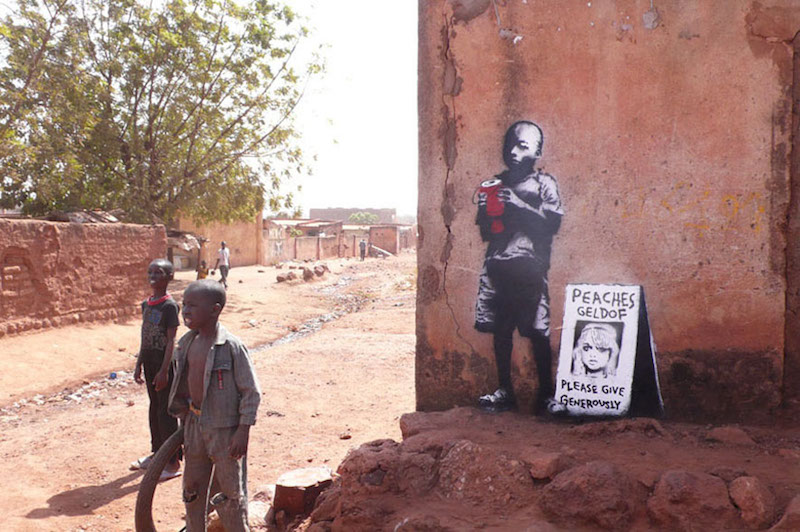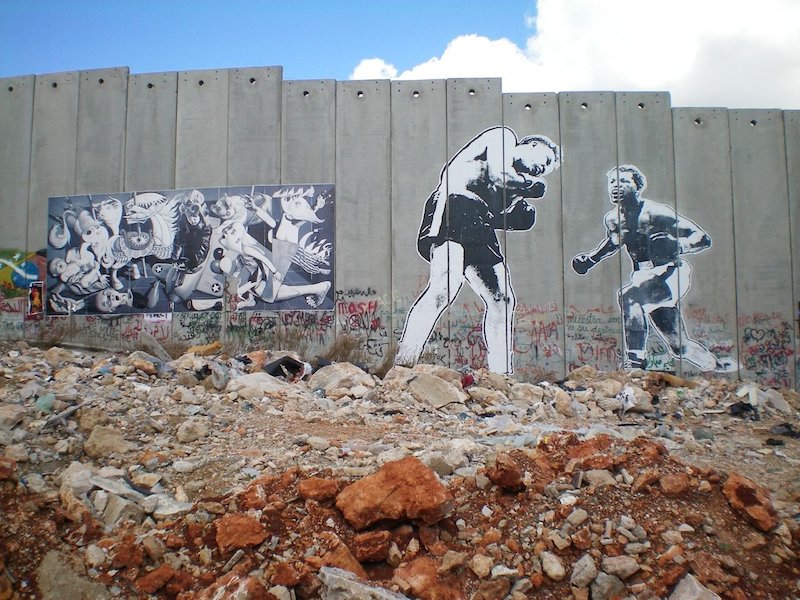
A 2008 piece by Banksy in Mali referencing British tabloid fixture Peaches Geldof. Photo from banksy.co.uk.
Even the king of street art, Banksy, has made work where it’s clear that he intends for the primary audience to see the work through a photograph. These works may not even make sense when viewed on the street. The most obvious example of this is a piece Banksy is believed to have painted around January 2009 in Mali.[1] The stencil depicts an African child holding a red charity collection tin and (according to the sign stenciled next to him) he is raising money forPeaches Geldof. While those not living in England may be unaware who Peaches is, she is a household name in the U.K. Peaches is the daughter of musician and political activistBob Geldof, the man behind theLive Aid andLive 8 charity concerts and the song“Do They Know It’s Christmas?”. Other than that, Peaches is basically an English socialite / famous for being famous.
It’s a funny stencil, but do most people walking by it every day get the reference? Since Peaches’ fame is primarily in the UK, it seems unlikely many people in Mali know who she is. The piece wouldn’t have made much more sense to residents of New York City either, but putting the piece in Africa created context that enhanced the joke, if you got the reference to begin with. And Banksy took a photo of the piece to bring back to England. The photofirst surfaced outside of Mali as part of installation at Banksy’sBanksy versus The Bristol Museum show in 2009.[2] In Bristol, the joke worked. Most visitors to the show would have known who Peaches Geldof is. Sometime after the show opened, a photo of the piece was also posted to Banksy’s website, along with other work from his trip to Mali. The Peaches Geldof piece began traveling around the web, where an audience who understood the British cultural reference shared the photo. All Banksy had to do was post a photo of his work on the internet. The Bored at Work Network took care of the rest.
While it can be nice when a great piece by Banksy lasts longer on the street than expected, in the case of the Peaches Geldof stencil, it hardly matters if the piece lasted two days after Banksy left town. He had his photograph. This particular piece may have had a larger impact online than if it remained visible and untouched on the street for ten years without photographic documentation.
In fact, the piece didn’t stay untouched for long. Through a representative, Banksy stated: “After I finished the piece and had a coffee I thought it was a bit obscure – they don’t even speak English there – it’s a former French colony. So I went back and painted over the Peaches bit and put a red heart on the board instead. I said to my local fixer, ‘I hope this connects more with the locals. He shrugged and said, ‘I think it was preferred before when you could tell it really meant something.’”
Given Banksy’s story, I may not be giving the local residents in Mali enough credit. Whether or not the locals understood the specific reference, they got the joke. But for people to get the reference, Banksy still had to post the photo online. While some street artists would just spray out a stencil anywhere they can find space, Banksy used geographic context to set a scene for the viewer back home in England.

Work put up by Ron English and Faile on the separation wall in the West Bank as part of Banksy’s Santa’s Ghetto project in Bethlehem. Photo by eddiedangerous.
On a related note, it’s worth mentioning Banksy’s Santa’s Ghetto project in Bethlehem, Palestine, which took place in 2007. Although at first Santa’s Ghetto might not appear to be much like JR’s work in Rio de Janeiro, it was quite similar and perhaps even more brilliantly organized and executed. Banksy got together a group of street artists to paint the separation wall that Israel is building in the West Bank. Of the project, Ron English (one of the participants) says, “Banksy’s idea was that there’s this group of street artists, and wherever they go, here comes the press taking pictures. So his idea was, ‘Well, fuck it. Let’s go to Palestine. If they’re all gonna follow us wherever we go and take pictures, and disseminate them, let’s go to Palestine. Let them see what the fuck’s going on there.’” The event got international media coverage. Images of the works were published online and in major newspapers around the world and sparked discussion about the Israel/Palestine conflict. The artwork even led to a small industry in Bethlehem showing tourists around to point out all the local street art.
- Zakdblair, Olly Courtney, and Melfeasance. "Banksy vs Bristol Musuem." flickr. Yahoo!, 15 June 2009. Web. 30 Oct. 2012. <http://www.flickr.com/photos/pixplosion/3629337369/>.↵
- Melfeasance, Ray182, Shell Shock, Lusername, and Eddiedangerous. "Hunting the Wild Banksy in Africa." flickr. Yahoo!, n.d. Web. 30 Oct. 2012. <http://www.flickr.com/groups/banksy/discuss/72157620466452332/>.↵